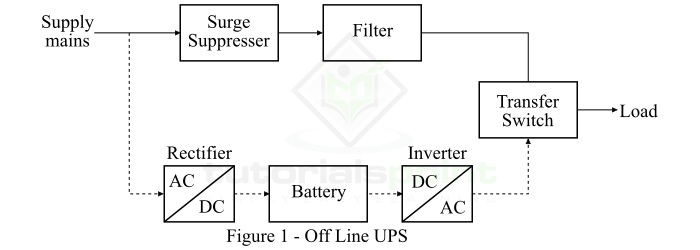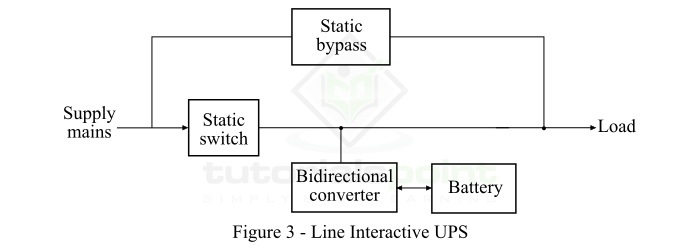
 Data Structure
Data Structure Networking
Networking RDBMS
RDBMS Operating System
Operating System Java
Java MS Excel
MS Excel iOS
iOS HTML
HTML CSS
CSS Android
Android Python
Python C Programming
C Programming C++
C++ C#
C# MongoDB
MongoDB MySQL
MySQL Javascript
Javascript PHP
PHP
- Selected Reading
- UPSC IAS Exams Notes
- Developer's Best Practices
- Questions and Answers
- Effective Resume Writing
- HR Interview Questions
- Computer Glossary
- Who is Who
Uninterruptible Power Supply (UPS) – Definition, Block Diagram, Types, and Applications
In this article, we will discuss the uninterruptible power supply (UPS), its block diagram, types, and applications. So, lets' begin with the basic definition of the uninterrupted power supply (UPS).
What is a UPS?
UPS stands for Uninterruptible Power Supply. An Uninterruptible Power Supply (UPS) is an electrical device used to provide emergency electrical power to different electrical loads in the case of a main power supply failure. A UPS or uninterruptible power supply uses batteries and supercapacitors to store electrical energy and delivers this stored electrical energy when the main input power supply fails. However, a typical UPS battery can supply electrical power for a short duration. Hence, UPSs are mostly used as short run time backup power sources for small loads.
In addition to supplying emergency electrical power to the loads, a UPS also protects sensitive equipment such as computers, data centers, TV sets, industrial process control and monitoring systems, and many other electronic devices.
A UPS is commonly used with computers that keep running a computer for a short time, about 15 to 30 minutes, after the failure of supply mains. Therefore, it prevents the sudden turn off of the computer and loss of data in the system, and other system failures. These days, there are several types of UPS systems available in the market. Some smart UPS systems are also available that come with software components that enables us to automate the switching function of the backup supply when we are away from the computer system.
Major Parts of an UPS
Following are the main components of a UPS system ?
Battery ? The battery works as the energy storage unit in the UPS system. It provides the stored electrical energy for a sufficient amount of time during main power failure.
Rectifier or Charger Circuit ? It converts the supply voltage of 240 VAC into 12 V (or any other battery voltage) DC. It supplies this rectified DC power to the battery for storage.
Inverter ? It converts the DC output power of the battery into ac power to supply the load during mains power failure.
Static Switch ? It is a semiconductor device such as a thyristor which transfers the load from the utility to the inverter (and the inverter to the utility) without any interruption in the power supply to the load.
Primary Function of a UPS
When there is any failure in the main power supply from the utility, the UPS supplies emergency power to the load for a short duration of time. This is the primary function of a UPS. Modern UPSs can also provide protection against electrical faults such as short-circuit, voltage fluctuations, low voltage, instability of mains frequency, etc.
Types of UPS
The uninterrupted power supply (UPS) systems are broadly classified into the following three types ?
- Off-Line UPS
- On-Line UPS
- Line Interactive UPS
Now, let us discuss each of these three types of UPS systems individually along with their block diagrams.
Off-Line UPS
The Off-Line UPS is also known as Standby UPS. This type of UPS system gives only the most basic features. In the case of off-line UPS, the system will start operating only when there is a power failure in the supply mains. The block diagram of the off-line UPS is shown in Figure-1.

In an off-line UPS system, the ac power from the supply mains is first converted into DC power using a rectifier circuit and then stored in the battery connected to the output port of the rectifier. When, there is any power failure that occurs in the supply mains, the dc power of the battery is converted into ac power using a power inverter and is then transferred to the load connected to the ups system. The off-line ups systems provide surge protection in addition to the emergency power. These are the least expensive UPS systems available in the market.
On-Line UPS
The On-Line UPS system uses a double conversion method. That means, in this UPS system, the input AC power is first converted into DC power by a rectifier to charge the UPS battery, and then this DC power is converted back into AC power by a power inverter to power the load equipment. Therefore, the On-Line UPS systems are commonly used in such systems where electrical isolation is required between the input and output. The block diagram of a typical On-Line UPS system is shown in Figure-2.

In this system, the rectifier circuit receives ac power from the supply mains and directly drives the inverter circuit. Thus, it involves two simultaneous conversion processes and is hence referred to as a Double Conversion UPS System.
In the case of supply mains power failure, the rectifier circuit becomes inactive and the DC power stored in the battery is converted into AC by the inverter and supplied to the load. Once the mains power is restored, the rectifier circuit again starts charging the battery. A current limiting mechanism is also provided in the system to protect the battery from overheating. Although, on-line ups systems are slightly expensive due to their design and components used.
Line Interactive UPS
The Line-Interactive UPS systems are connected in parallel with the AC mains in a standby configuration so that these systems can interact with the AC input system. These types of UPS systems are mainly used in small businesses and offices. The block diagram of a line interactive UPS system is shown in Figure-3.

Under normal operating conditions, the load is supplied with AC power through a parallel connection of the AC source and the bidirectional converter. The converter charges the battery, and also provides AC power to the load in the situation of breakage of supply mains. In this type of UPS system, a bypass is also provided which transfers the load to a bypass AC input when the UPS fails to function. The line-interactive UPS systems are well suited for medium to high power rating loads.
Applications of UPS
These days, UPS systems are very common in almost all electrical and electronic systems. Following are some of the important applications of different types of UPS systems ?
UPS systems are used in computer data centers.
UPS systems are used in industrial control and monitoring systems.
UPS systems are also used in telecommunication systems.
They are also used in hospitals, banks, insurance offices, and other commercial applications for backup power, etc.
Conclusion
From the above discussion, it may be concluded that the UPS is an electrical device used to provide emergency electrical power under the failure of supply mains. Modern UPS systems are also able to provide several types of protection such as short circuit, low voltage, voltage fluctuation, frequency variation, etc.
Based on the design and operation, the UPS systems are classified into three main types namely off-line UPS, on-line UPS, and line-interactive UPS. UPS systems are widely used in computer systems, houses, businesses, and industries as backup power supply systems.

